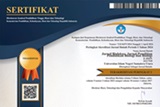ASPEK REPRODUKSI UDANG MANTIS Harpiosquilla raphidea DI EKOSISTEM MANGROVE KABUPATEN LABUHANBATU, SUMATERA UTARA
Abstract
Keywords
Full Text:
PDFReferences
Ahyong, S. T., & Moosa, M. K. (2004). Stomatopod Crustacea From Anambas and Natuna Islands, South China Sea, Indonesia. The Raffles Bulletin of Zoology, (11), 61–66.
Astuti, I. R., & Ariestyani, F. (2013). Potensi dan Prospek Ekonomi Udang Mantis di Indonesia. Pusat Penelitian Dan Pengembangan Perikanan Budidaya, 8(1), 39–44.
Barber, P. H., & Erdmann, M. V. (2000). Molecular systematics of the Gonodactylidae (Stomatopoda) using mitochondrial cytochrome oxidase C (Subunit 1) DNA sequence data. Journal of Crustacean Biology, 20(2), 20–36. https://doi.org/10.1163/1937240X-90000004
Damora, A. (2010). Biologi Reproduksi Udang Mantis Harpiosquilla raphidea Di Perairan Kuala Tungkal, Tanjung Jabung Barat, Jambi [Skripsi]. Institut Pertanian Bogor.
Dimenta, R. H., Machrizal, R., & . K. (2019). Information Reproductive Morphology And Sex Ratio of Mantis Shrimp Cloridopsis scorpio in Belawan’s Aquatic Ecosystems Mangrove, 5(2), 24–33.
Dimenta, R. H., Machrizal, R., Khairul, K., Hasibuan, R., Manurung, A. Q., & Ihsan, M. (2020). Biologi reproduksi udang mantis Cloridopsis scorpio di ekosistem mangrove Belawan, Sumatera Utara. Depik, 9(2), 227–334.
Djuwito, D, Saputra, S. W., & Widyaningtiwi, W. A. (2013). Beberapa Aspek Biologi Udang Mantis (Oratosquilla oratoria De Haan, 1844) Di Perairan Cilacap, Jawa Tengah. Management of Aquatic Resources Journal (MAQUARES), 2(3), 56–64. https://doi.org/10.14710/marj.v2i3.4182
Djuwito, D., Saputra, S. W., & Widyaningtiwi, W. A. (2013). Beberapa Aspek Biologi Udang Mantis di Perairan Cilacap, Jawa Tengah. Journal Management of Aquatic Resources, 2(3), 56–64.
Hamid, A., Wardiatno, Y., Batu, D. T. F. L., & Riani, E. (2015). Fekunditas Dan Tingkat Kematangan Gonad Rajungan (Portunus pelagicus) Betina Mengerami Telur Di Teluk Lasongko, Sulawesi Tenggara. Bawal, 7(1), 43–50. https://doi.org/10.15578/bawal.7.1.2015.43-50
Jacoeb, A. M., Cakti, N. W., & Nurjanah, N. (2008). Perubahan Dan Komposisi Protein Dan Asam Amino Daging Udang Ronggeng (Harpiosquilla raphidea) Akibat Perebusan. Buletin Teknologi Hasil Perikanan, XI(1), 1–20.
Kim, S. E., Kim, H. J., Bae, H. J., Kim, H. G., & Oh, C. W. (2017). Growth and Reproduction of the Japanese Mantis Shrimp, Oratosquilla oratoria (De Haan 1844) in the Coastal Area of Tongyeong, Korea. Ocean Science Journal, 52(2), 257–265. https://doi.org/10.1007/s12601-017-0027-2
Lisna, L., Nelwida, N., & Ramadan, F. (2021). Keanekaragaman Hasil Tangkapan Sondong di Perairan Laut Kuala Tungkal Kabupaten Tanjung Jabung Timur. Jurnal Kelautan, 14(2), 100–110.
Mashar, A., & Wardiatno, Y. (2011). Distribusi Spasial Udang Mantis Harpiosquilla raphidea dan Oratosquillina gravieri di Kuala Tungkal, Kabupaten Tanjung Jabung Barat, Provinsi Jambi. Jurnal Pertanian UMMI, 1(1), 41–46.
Mulyono, M, Patria, M. P., Abinawanto, A, Affandi, R., & Mardiyono. (2017). The Development of Gonad Mantis Shrimp Harpiosquilla raphidea Fabricius, 1798 in Banten Bay, Indonesia. International Journal of Aquatic Science, 8(1), 26-33. https://doi.org/10.31219/osf.io/2mw3t
Mulyono, M. (2013). Kajian Keragaman Genetik Aspek Pertumbuhan Dan Reproduksi Udang Mantis Harpiosquilla raphidea fabricius 1798 di Perairan Teluk Banten Sebagai Upaya Konservasi [Disertasi]. Universitas Indonesia.
Murni, S., & Dimenta, R. H. (2021). Bioekologi Udang Swallow (Penaeus merguiensis). BIOEDUSAINS: Jurnal Pendidikan Biologi Dan Sains, 4(1), 99–111. https://doi.org/10.31539/bioedusains.v4i1.2282
Situmeang, N. S., Purnama, D., & Hartono, D. (2017). Identifikasi Spesies Udang Mantis (Stomatopoda) Di Perairan Kota Bengkulu. Jurnal Enggano, 2(2), 239–248. https://doi.org/10.31186/jenggano.2.2.239-248
Sukarni, S., Rina, R., Samsudin, A., & Purna, Y. (2018). Harpiosquilla raphidea, Udang Belalang Komoditas Unggulan dari Provinsi Jambi. Jurnal Penyuluhan Perikanan Dan Kelautan, 12(3), 174–188. https://doi.org/10.33378/jppik.v12i3.108
Wardiatno, Y., & Mashar, A. (2010). Biological information on the mantis shrimp, Harpiosquilla raphidea (Fabricius 1798) (Stomatopoda, Crustacea) in Indonesia with a highlight of its reproductive aspects1. Journal of Tropical Biology and Conservation, 7(1), 65–73.
Wedjatmiko, W. (2017). SEBARAN DAN KEPADATAN UDANG MANTIS (Carinosquilla spinosa) DI PERAIRAN ARAFURA. Jurnal Penelitian Perikanan Indonesia, 13(1), 61–69. https://doi.org/10.15578/jppi.13.1.2007.61-69
Wowor, A. R. Y., Bagau, B., Untu, I., & Liwe, H. (2015). Kandungan Protein Kasar, Kalsium, Dan Fosfor Tepung Limbah Udang Sebagai Bahan Pakan Yang Diolah Dengan Asam Asetat (Ch3Cooh). Zootec, 35(1), 1–9. https://doi.org/10.35792/zot.35.1.2015.6380
DOI: http://dx.doi.org/10.30821/biolokus.v5i1.1297
Refbacks
- There are currently no refbacks.
Copyright (c) 2022 Jurnal Biolokus: Jurnal Penelitian Pendidikan Biologi dan Biologi
indexed by :












